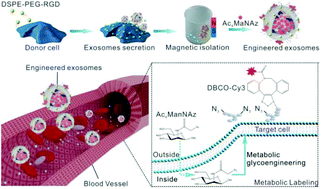The use of RGD-engineered exosomes for enhanced targeting ability and synergistic therapy toward angiogenesis†
Abstract
Promoted therapeutic angiogenesis is a major objective in the area of regenerative medicine, and sufficient vascularization of artificial tissues or organs is one of the main difficulties for the realization of tissue engineering methods. The identification of new kinds of pro-angiogenic materials will greatly profit developments in regenerative medicine. The use of exosomes for this intention is a considerably new idea developed in recent years. However, several limitations need to be addressed before their use as clinical therapeutics, including the lack of efficient exosome enrichment and methods to endow exosomes with targeting ability. Herein, we pioneered biomimetic particles with topographic structures for exosome isolation. Using this system, nearly 80% of exosomes were isolated in 30 min. Through a donor cell-assisted membrane modification strategy, the isolated exosomes exhibited increased targeting to blood vessels due to the modified Arg-Gly-Asp (RGD) peptide on the exosome membrane, and simultaneously possessed a synergistic therapeutic angiogenesis effect and angiogenesis imaging attributed to metabolic labeling by click chemistry both in vitro and in vivo. The engineered exosomes represent a potential new therapeutic tool for angiogenesis therapy and imaging in a bio-friendly manner.



 Please wait while we load your content...
Please wait while we load your content...